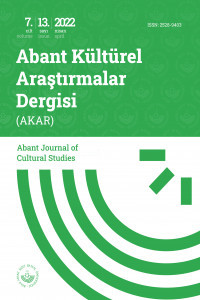Roma Dönemi cam kaplarında temenni yazıtları
MÖ 1. yüzyıl dolaylarında, cam endüstrisine yeni yönünü kazandıran “üfleme tekniği”nin keşfi sonrasında cam eserler, dönemin en büyük gücü olan Roma İmparatorluğunun topraklarında hiç olmadığı kadar yayılım alanına sahip oldular. Hem dekorasyon hem form çeşitliliği ile hayatın her alanında zengin kullanım alanı buldular. Buna paralel olarak, o döneme kadar, teknik zorluklardan ötürü cam kaplar üzerinde nadiren karşımıza çıkan yazıt kullanımı da giderek çoğaldı ve temenni, anma, kutlama gibi pek çok farklı amaçla uygulandı. Bahsi geçen bu gruplardan olan “Temenni Yazıtları” özellikle Roma günlük hayatını algılamak ve bu döneme odaklanan kültürel araştırmalara katkı sağlamak adına ayrıcalıklı bir öneme sahiptir. Burada yer alan çalışma ise modern arkeoloji literatüründe oldukça dağınık olarak karşımıza çıkan bu yazıtları Roma kültür tarihi içerisinde ele alarak örneklendirmeyi ve kullanım şekilleri bağlamında sorgulamayı amaçlamaktadır.
Anahtar Kelimeler:
Arkeoloji, kültür tarihi, Roma Dönemi, cam, antik cam, Roma camı, yazıt
The well-wishing inscriptions on Roman glass vessels
Around 1st century B.C., after the invention of the technique of glassblowing which gave a new direction to the glass industry, glass products spread unprecedentedly around the territory of the Roman Empire, the most powerful state of the period. Glass products having decorative and form richness were widely used in every sphere of life. Correspondingly, the inscriptions, which has been rarely encountered up to that time because of the technical difficulties, started to be widely used for wish, commemorating, celebration etc. “The Well-Wishing Inscriptions” have an exclusive importance for understanding especially the Roman daily life and thus contributing to the cultural studies focusing on this period. This work aims to give examples of those inscriptions, which are very dispersedly found in modern archeology literature, in the context of Roman cultural history and to think on their areas of usage.
Keywords:
Archaeology, cultural history, Roman Period, glass, ancient glass, Roman glass, inscription,
___
- Avery, C. Louise (1921) Early Christian Gold Class. The Metropolitan Museum of Art Bulletin, 16 (8): 170-175.
- Blid, Jesper (2016) Labraunda 4: Remains of Late Antiquity. Stockholm: Swedish Research Institute in Istanbul.
- Borzic, I. (2008) Ennion Caze ez Burnuma. Archaeologia Adriatica II, 91-101.
- Buljevic, Zrinka (2009) Traces of Glassmakers in the Roman Province of Dalmatia. Quaderni Friulani di Archeologia XIX, 35-50.
- Carnevale, Valeria (2015) Diatreta Cups, Light in Roman Dining Spaces. ArchTheo '15 Theory and History of Architecture'conference proceedings, Istanbul: DAKAM Publishing, 478-487.
- Christodoulou, Naomi (2014) Dionysian Religion: A Study of the Worship of Dionysus in Ancient Greece and Rome. Yayımlanmamış Yüksek Lisans Tezi, Greece: University of Patras.
- Cooley, Alison E. (2014) The Cambridge Manuel of Latin Epigraphy. Cambridge: Cambridge: University Press.
- Elmer, David F. (2013) Poetry’s Politics in Archaic Greek Epic and Lyric. Oral Tradition, 28(1): 143-166.
- Eroğlu, Ahmet Hikmet (1999) Ekmek – Şarap Ayini (Evharistiya) Konusunda Katolikler ve Protestanlar Arasındaki Anlayış Farklılıkları. Ankara Üniversitesi İlahiyat Fakültesi Dergisi, 1: 439-453.
- Erten, Emel (2001) Türkiye Dışındaki Müzelerde Bulunan Anadolu Kaynaklı Roma Cam Eserleri Işığında Anadolu’da Cam. Türk Arkeoloji ve Etnografya Dergisi, 2: 73-82.
- Freestone, Ian vd (2007) The Lycurgus Cup-A Roman Nanotechnology. Gold Bulletin, 40(4): 270-277. Gebhardt,
- Maritha Elin (2010) The Common Wine Cult of Christ and the Orphic Dionysos: the Wine and Vegetation Saviour Deity Dionysos as Model for the Dying and Rising Christ. Yayımlanmamış Yüksek Lisans Tezi, Oslo: University of Oslo.
- Gençler, Çiğdem (2000) Sminteion Camları. Yayımlanmamış Yüksek Lisans Tezi, Ankara: Ankara Üniversitesi Sosyal Bilimler Enstitüsü.
- Grossman, Richard (2002) Ancient Glass: A Guide to the Yale Collection. New Haven: Yale University Art Gallery.
- Gürler, Binnur (1998) An Inscribed Bowl Decorated with Wheel Abrasion-Technique in Western Anatolia. Anatolian Studies, 48: 171-173. Harden, Donald B. (1987) Glass of the Caesars. Milan: Olivetti.
- Hayward, Christopher (2015) Contextualizing the Archaeometric Analysis of Roman Glass. Yayımlanmamış Yüksek Lisans Tezi, Cincinnati: University of Cincinnati.
- Homeros (2013) Çev. Azra Erhat – A. Kadir, İstanbul: Can Yayınları.
- Howells, Daniel Thomas (1985) A Catalogue of the Late Antique Gold Glass in the British Museum. London: The British Museum Press. Klein, Dan ve Lloyd, Ward (2000) The History of Glass. London: Little and Brown.
- Lightfoot, Christopher S. (2014) Ennion and the History of Ancient Glass. Ennion: Master of Roman Glass, Ed. Christopher Lightfoot, ss. 15-49. New York.
- Lutraan, Katherine (2006) Late Roman Gold- Glass: Images and Inscriptions. Yayımlanmamış Yüksek Lisans Tezi, Hamilton: McMaster University.
- Martin, Damien (2010) When to Say When: Wine and Drunkness in Roman Society. Yayımlanmamış Yüksek Lisans Tezi, Missouri: University of Missouri.
- Özgümüş, Üzlifat (2015) Marmaray-Sirkeci Buluntusu Ennion Camı Metropolitan Museum Kataloğu’nda. Arkeoloji ve Sanat Dergisi, 149: 155-156.
- Shlomo Moussaieff Collection (2016) Ancient Glass from the Shlomo Moussaieff Collection. Chriestie’s London.
- Stern, Marianne (1995) Roman Mold-blown Glass: the First Through Sixth Centuries, Rome: "L'Erma" di Bretschneider.
- Taştemür, Emre (2007) Klaros Cam Eserleri. Yayımlanmamış Yüksek Lisans Tezi, Edirne: Trakya Üniversitesi Sosyal Bilimler Enstitüsü.
- Taştemür, Emre (2017) Harput İç Kale Kazısı Cam Fırınlarına Ait İlk Gözlemler. SDÜ Fen-Edebiyat Fakültesi Sosyal Bilimler Dergisi, 41: 69-79.
- The J. Paul Getty Journal (1996) Acquisitions/1995. Volume 24, Los Angeles.
- Weitzmann, Kurt (1979) Age of Spirituality: Late Antique and Early Christian Art, Thirt to Seventh Century. New York: Metropolitan Museum of Art.
- Whitehouse, David (1997) Roman Glass in the Corning Museum of Glass Volume I. New York: Corning Museum of Glass.
- Whitehouse, David (2002) Roman Glass in the Corning Museum of Glass Volume II. New York: Corning Museum of Glass.
- Yayın Aralığı: Yılda 2 Sayı
- Başlangıç: 2016
Sayıdaki Diğer Makaleler
Roma Dönemi cam kaplarında temenni yazıtları
Erving Goffman: Günlük Yaşamda Benliğin Sunumu (Kitap eleştirisi)
Transmedya hikâye anlatıcılığı: Kötü Çocuk örneği
Konfüçyüsçülük’teki Tian kavramının incelenmesi
Collective identity and traumatic memory in the cinematic expression
Görsel hazzın dişil örüntüleri: Mavi Kod (Code Blue)
Türk basın tarihinde taşrada yayınlanan bir merkez gazetesi: Ülke
